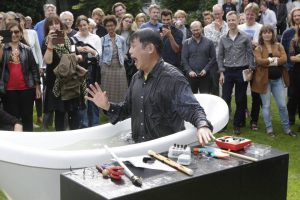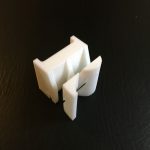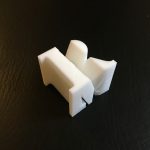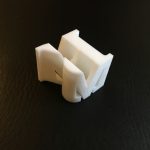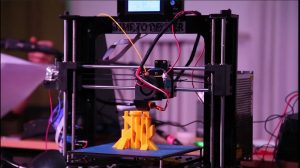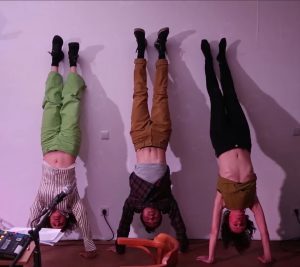Adachi is only one internationally active sound poet from Asian countries. He presented Japan premiere of “Ursonate” by Kurt Schwitters in 1996. He has performed not only his own poems, but also historical Dada/Futurist poems, especially focused on a little known history of modern Japanese sound poetry which started from Japanese Dada/Futurism movement in 1924.
Gestures and physical movements are an important aspect of his sound poetry practise. He focuses on writing gestures. Also he combines electronics with the performances.
See also voice/electronics
See also Berlin Sound Poet Quoi Tête
List of selected own sound poems
Hand-sign translation of Kurt Schwitters’ “Ursonate” the third movement (2018) translation of no-meanings
Speech is irreversible (2017) by Tomomi Adachi / Annika Haas
A text based on fragments generated by Markov chain from Annika Haas’ theoretical/conceptual text.
Dancing with Hauer (2017) text with audio playback.
The text was composed with the compositional system by Josef Matthias Hauer. Commissioned by Kakania project/Austrian Culture Forum
Ursonate 2 (2014) Surround 5.1 channel/fixed media
Electro-acustic sound poem based on Kurt Schwitters’ Ursonate
Commissioned by IMRC Center, University of Maine and Pogus Productions
The recording is available here.
This means “Oh boy, that BBQ meat is too big.” (2012)
Recorded for Huellkurven Issue 1
Psalm (2012) a dictation of glossolalia
Recording is available on Where the gap between poor and rich comes from (CD)
(silent words) (2012) Conceptual sound poem.
The text (spell) exits only in the brain of the author, never written, only memorized. It is performed as a sequence of facial movements, any kind of recording is not permitted. The piece was inspired by “Orasho”, a practice of hidden Christians in Japan.
Voice Sound Poetry Form Ended With -X- (2012)
A repetitive extended remix of Japanese first sound poem “Voice Sound Poetry Form Begun with -X-” written by futurist painter Hide Kinoshita in 1924. It was premiered as a part of MAVOtek part I. Video
Face (2009) with Gestures
Japanese translation of Kurt Schwitters’ “Ursonate” the third movement (2008) translation of no-meanings
Osuterokomusa (2007) Bilingual canonic text operations
Recording is available on Where the gap between poor and rich comes from (CD)
devenir (2007) multilingual collage text
Published on Playing With Words: The spoken word in artistic practice
Schwitters Variations (2001) Variations on the theme of Kurt Schwitters’s “Ursonate”)
Recording Ubuweb
Sekan-no-syu (2001) Wrong pronunciations of Japanese old poem. Originally written for a dance accompaniment
ANATA 1-5 (1995-2001) Systematic permutation/accumulation poems with dramatic meanings in Japanese
Recording ANATA 2 (bandcamp), ANATA 5 (Ubuweb)
ANATA 5 was published on Playing With Words: The spoken word in artistic practice and [Three] Factorial
List of selected repertoires
-Dada/Futurism, Beat and Fluxus-
Kurt Schwitters: Ursonate, bii büll ree, Das Ganze husten
Olga Rozanova: Untitled Zaum
Elsa von Freytag-Loringhoven – Eigasing rin Jalamund (Video)
Hugo Ball: Gadji Beri Bimba (Video), Seepferdchen und Flugfishche
Fortunato Depero: Canzone Futurista
Brion Gysin: I AM THAT I AM (Video)
Dick Higgins: Glasslass
Nam June Paik: Tanka
Tristan Tzara: X Y H X K K S W G (New poem written by the spirit of Tzara in 2014, See Dada Seance)
-Japanese Sound Poetry (Video)-
(this list is a brief chronological table of Japanese sound poetry, appended original published years). Especially, he arranged Voice Sound Poetry Form Begun with -X- in many performances.
Hide KINOSHITA: Voice Sound Poetry Form Begun with -X- (1924)
MATSUZAWA Yutaka: Symbol Poem (1954)
SUZUKI Shirouyasu: Lyric Poetry Based on a Oral Muscle Sensation Theory (1959)
NIIKUNI Seiichi: Opus A, Opus Fu, For a Flower Position, The Second Hand, Opus Po, Opus Mi, Opus Wa, Opus Me, O.N.NA, Opus Ta, Opus KI, Opus 9, U.MU, MA.TSU.RI, KI.MO.NO, Opus a (1960-1963), Rain (1966), Cherry Blossoms and Camels (1968), Sea has already been reduced to pus (1971), Touch (1972), Exorcism (1974)
KAN-NO Seiko: from “SU-Shi” (1971)
HAGA Toru: Ki-Ka (1994)
NAKAZAWA Hideki: Japanese Syllabic Monophony (1999-2002)
MATSUI Shigeru: Sound Poetry (2010)
Cosmic Poem – sound poetry from outer space (2014) with Akihiro Kubota
Sound art, experimental poetry practice. Sound poetry was generated in an artificial satellite and sent to the earth.
Details and recordings are here. https://cosmicpoem.wordpress.com/about/
Sound Poetry in a Bath (2007)
The performative rendition of “Voice Sound Poetry Form Begun With -X-“ bu Hide Kinoshita. This performance was presented in many occasions.
Duo version with Jennifer Walshe
Pluto is a planet! (2018) with Hannah Silva
See also voice/electronics
Finish-Japanese homophonic translations (2012-) with Cia Rinne
Finish language and Japanese language have very similar sounds, but not on meanings at all. In this translation project, Finish and Japanese poets translate poems in each other’s language into another phonetically, just replace words which has the closest sounds.
See also MAVOtek
RWR (2019) with Cia Rinne
Interpretations with voices, movements and video, of visual poems by legendary East German poet, Ruth Wolf-Rehfeldt.
3D tactile score for the performance.
- RWR
- RWR
- RWR
See also visual poetry
Time to deliver: X³ (2017) with Daniel Malpica
A collaborative sound poetry/multi-media performance with poet/designer, Daniel Malpica with 6 guest performers.
Amplified 3D printer is a central material of the theatrical performance.
- Time to deliver: X³
- Time to deliver: X³
Guest performers (voice, movement)
Barbara Lázara, Eiji Takeda , Charlotte Pauwelyn, María Ferrara, Amelie Baier, Grilowsky
Sound Poetry and Tomomi Adachi on Arte TV (2018)
German
French

